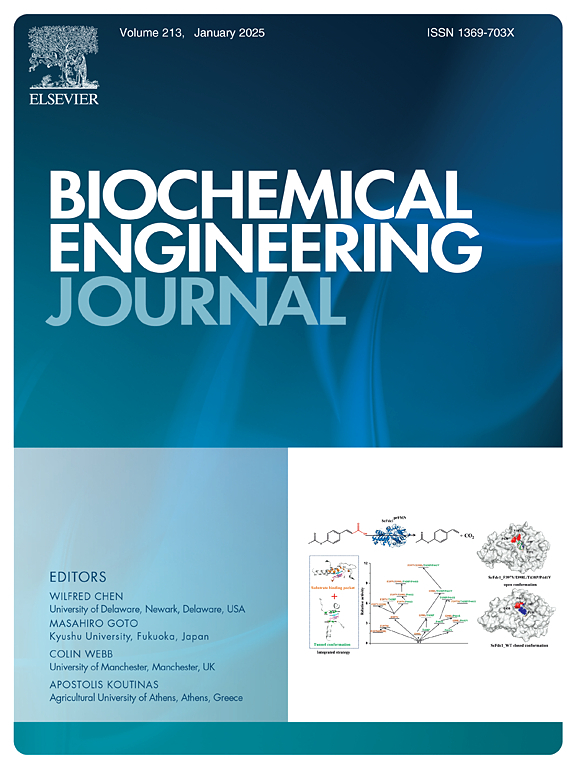阿魏酸脱羧酶工程的综合策略,具有适应非天然底物的隧道构象和底物口袋
IF 3.7
3区 生物学
Q2 BIOTECHNOLOGY & APPLIED MICROBIOLOGY
引用次数: 0
摘要
阿魏酸脱羧酶(Fdc1)可催化木质素中阿魏酸衍生物的脱羧反应,其底物谱很广。然而,Fdc1 对苯环上连接有笨重取代基的非天然底物的催化效率限制了其应用。在此,研究人员开发了一种综合策略,从酿酒酵母中设计 ScFdc1,专门针对 4-乙酰氧基肉桂酸生产 4-乙酰氧基苯乙烯,后者广泛用于光阻单体。该策略需要整合酶的两个结构方面,即进入隧道和底物结合口袋的构象。从 1248 个变体库中找出了对酶的性能有重大影响的六个变体。整合突变体的两个方面后,产生了 ScFdc1_F397V/I398L/T438P/P441V 变异体,对 4-乙酰氧基肉桂酸的活性提高了 11.8 倍以上。结构分析表明,与野生型的封闭状态相比,该变体采用了开放的隧道构象,隧道瓶颈处的最小距离从 0.7 纳米增加到 1.4 纳米。此外,还发现了一个重塑的结合口袋,通过酶学和分子动力学分析证实,该口袋有助于底物的可及性和结合亲和力。这些结果不仅通过积累有益的突变体为酶工程提供了策略,而且为苯乙烯衍生物的可持续生产提供了一条前景广阔的途径。本文章由计算机程序翻译,如有差异,请以英文原文为准。
Integrated strategies for engineering ferulic acid decarboxylase with tunnel conformation and substrate pocket for adapting non-natural substrates
Ferulic acid decarboxylase (Fdc1) catalyzes the decarboxylation of ferulic acid derivatives from lignin with broad substrate spectra. However, the catalytic efficiency of Fdc1 across non-natural substrates with bulky substituents attached to the benzene ring limits its application. Here, an integrated strategy was developed to engineer ScFdc1 from Saccharomyces cerevisiae, specifically targeting 4-acetoxycinnamic acid for the production of 4-acetoxystyrene, which was widely used in photoresists monomers. The strategy entailed the integrating two structural aspects of the enzyme, the conformation of the access tunnel and the substrate binding pocket. Six mutants from a 1248-variant library with significant impacts on enzyme performance were identified. Integration of the two aspects of the mutants achieved the ScFdc1_F397V/I398L/T438P/P441V variant, exhibiting over an 11.8-fold activity improvement towards 4-acetoxycinnamic acid. The variant adopts an open tunnel conformation against that the closed state in the wild type, as revealed by structural analysis with the minimal distance at the bottleneck of the tunnel increased from 0.7 to 1.4 nm. Additionally, a reshaped binding pocket is identified which facilitates the substrate accessibility and binding affinity confirmed by enzymatic and molecular dynamics analysis. The results not only provide strategies for enzyme engineering through the accumulation of beneficial mutants, but also offer a promising route for sustainable styrene derivative production.
求助全文
通过发布文献求助,成功后即可免费获取论文全文。
去求助
来源期刊

Biochemical Engineering Journal
工程技术-工程:化工
CiteScore
7.10
自引率
5.10%
发文量
380
审稿时长
34 days
期刊介绍:
The Biochemical Engineering Journal aims to promote progress in the crucial chemical engineering aspects of the development of biological processes associated with everything from raw materials preparation to product recovery relevant to industries as diverse as medical/healthcare, industrial biotechnology, and environmental biotechnology.
The Journal welcomes full length original research papers, short communications, and review papers* in the following research fields:
Biocatalysis (enzyme or microbial) and biotransformations, including immobilized biocatalyst preparation and kinetics
Biosensors and Biodevices including biofabrication and novel fuel cell development
Bioseparations including scale-up and protein refolding/renaturation
Environmental Bioengineering including bioconversion, bioremediation, and microbial fuel cells
Bioreactor Systems including characterization, optimization and scale-up
Bioresources and Biorefinery Engineering including biomass conversion, biofuels, bioenergy, and optimization
Industrial Biotechnology including specialty chemicals, platform chemicals and neutraceuticals
Biomaterials and Tissue Engineering including bioartificial organs, cell encapsulation, and controlled release
Cell Culture Engineering (plant, animal or insect cells) including viral vectors, monoclonal antibodies, recombinant proteins, vaccines, and secondary metabolites
Cell Therapies and Stem Cells including pluripotent, mesenchymal and hematopoietic stem cells; immunotherapies; tissue-specific differentiation; and cryopreservation
Metabolic Engineering, Systems and Synthetic Biology including OMICS, bioinformatics, in silico biology, and metabolic flux analysis
Protein Engineering including enzyme engineering and directed evolution.
 求助内容:
求助内容: 应助结果提醒方式:
应助结果提醒方式:


